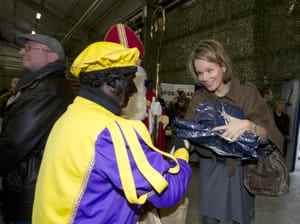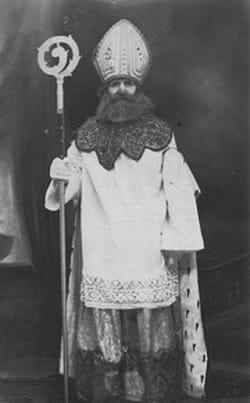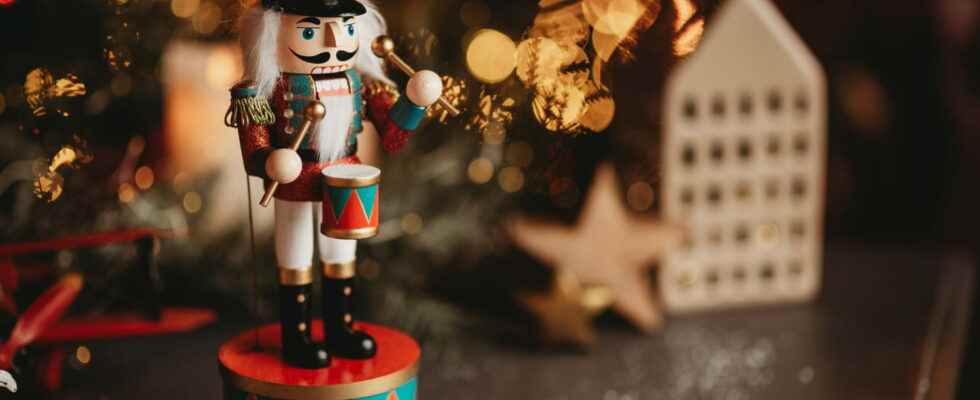SAINT-NICOLAS 2022. Who is Saint Nicolas really, who really existed and inspired our current Santa Claus? Date, history, celebrations, songs, legends… Here are its secrets!
[Mis à jour le 5 décembre 2022 à 10h56] The “December 6 party” takes place on a Tuesday this year! It is obviously Saint Nicholas, which celebrates a Christian saint from the beginning of the 4th century. It is he who will inspire the existence of our Father Christmas, appeared much later, in the 20th century following a commercial initiative! The story of Saint Nicolas is unknown: he was a bishop living in Myre (south of present-day Turkey). Many miracles are then attributed to the man and make his legend.
The best known of these exploits? The man of faith is said to have miraculously resuscitated three children cut up by a butcher, who intended to make only one mouthful of their tender flesh after passing them through the salting tub… Saint Nicolas would later become the patron saint of good children, but also of sailors, tradesmen, single people or even burn victims (!). He will also acquire the key role of Saint Protector of Russia.
During the Saint-Nicolas festivities, just as in his representation at the heart of the child’s imagination, Saint Nicolas forms a contrasting pair with a much less sympathetic friend, the famous Père Fouettard. His main mission? Punish naughty children. As for the celebrations, parades of floats, torchlight processions and markets enliven the streets of several regions of eastern France and northern Europe. Date, song, legends… Immerse yourself, thanks to this special page, in the joyous backstage of the universe of “good Saint Nicolas”!
Like any self-respecting saint, Saint Nicolas now has a date of his own in our calendar, December 6. It is on this date that he visits homes to reward good students who deserve happy holidays. Germany began to mark it with a white stone in the 10th century! Saint Nicholas is also a tradition in the Nordic countries. Dutch and Germans imported his legend to the United States, from the 17th century. French regions also celebrate its “coming” very early: particularly popular in the North of France, it is even more so in the East of the country. Saint Nicolas comes every December 6 to see schoolchildren in Lorraine and distribute sweets, gingerbread and chocolate as they welcome him with song. It also parades along the streets under the shining eyes of young and old. In Nancy, for example, the Saint Nicolas celebrations traditionally last a whole weekend. And they mix XXL fireworks, a parade of floats and even the symbolic handing over of the keys to the city to the Saint-Patron by the mayor himself. In short, between music, parade and market, the rites of Saint Nicolas are still celebrated every year in Lorraine, as at Nancy or even in the North, in Valenciennes, and rocked by songs and legends. The enigmatic ancestor of Santa Claus is still the protective patron of children, especially if they have been well behaved. But the good Saint Nicolas is also the patron saint of sailors, prisoners, lawyers, physiotherapists or even single men (when Saint Catherine is that of single women).
To approach the great and amazing story of Saint Nicolas, why not start with this nursery rhyme which still resonates in certain regions of France? The song of Saint Nicolas gives voice to a child who promises to be good, “like a sheep” and to learn his lessons to “have sweets”. This could be the slogan of schoolchildren who sing it every December 6 (date of Saint Nicholas) to welcome their patron Saint… Already, the shadow of modern Santa Claus is emerging behind rather outdated stanzas. Here are the lyrics of the song of Saint Nicolas according to the specialized site fete-enfants.com:
O great Saint Nicholas,
patron of schoolchildren,
bring me apples
In my little basket.
I will always be wise
Like a small picture.
I will learn my lessons
To get candy.
Come, come, Saint Nicholas,
Come, come, Saint Nicholas,
Come, come, Saint Nicolas, and tra la la…
O great Saint Nicholas,
patron of school children
bring me toys
In my little basket.
I will always be wise
Like a little sheep.
I will learn my lessons
To get candy.
Come, come, Saint Nicholas,
Come, come, Saint Nicholas,
Come, come, Saint Nicolas, and tra la la…

Saint Nicolas is always greeted with joy by schoolchildren or during his parade in the cities, but the arrival of the Fouettard (whose story you will discover a little later in this file) is, unsurprisingly, less welcome among the children. But also sometimes with their parents: in 2014, a controversy took place in the Netherlands at the start of the annual Saint-Nicolas procession… as to the supposedly racist character of the character of Zwarte Piet, or Pierre le Noir (the version dutch of the bogeyman).
“Have you children been good?” – “Yeesssssssssssssssssssssssssssssss.s are mostly answered by young people. Since the Middle Ages, Saint Nicholas has been going from home to home on the night of December 5 to 6 (it is in everything case what the legend says) to ask the children if they have been good. Two options: the brats have been and receive gifts; or else they have not shone with their discipline and Father Fouettard, a pair of Saint-Nicolas, gives them a correction.
If Saint-Nicolas is so popular, it is because from the Middle Ages, he inherited a cap: that of patron saint of schoolchildren. It is said that he owes it to his many miracles. And not just any. For example, he would have resuscitated three poor schoolboys cut into pieces by a butcher and thrown into a salting-tub… Said butcher will give birth to the legend of the wicked Père Fouettard (read below). Another legend tells how the future “real” Santa Claus saves a man in debt from selling his three daughters as slaves to get by (a classic process in antiquity): for three consecutive nights, the bishop of Myra throws enough money in the family home (through the window or the chimney, the versions differ) so that the father can repay his debts and provide his daughters with a dowry. Another legend says that the good Saint-Nicolas would have saved from the storm a boat carrying a cargo of wheat for the city of Myre. Stories inspired by very real Byzantine icons. Little by little, the tradition of Santa Claus will supplant that of his inspiration.

Saint Nicolas wears a recognizable look (miter on his head, crosier in hand and ecclesiastical habit on his back), because he was a bishop in another life! It was in the 4th century, in Asia Minor – in other words, in the southwest of present-day Turkey. Victim of persecutions under the reign of Diocletian, Nicolas de Myre, as he was called then, is especially talked about after his death, on December 6th. We remember him as protector, benevolent and generous, of the widow and the orphan.
And his past is particularly original: Nicolas de Myre was born in Turkey, in a port of Anatolia, around the 3rd century AD. He will become a bishop at a very young age, in a part of Asia where the Christian religion was in its infancy. Withdrawn on an island, renamed the island of Saint-Nicolas, he will then settle in Myre, the modern city of Demre, which will give him his surname. He would be particularly known in the early years for his fight against pagan cults in this period of Christmasstill returned to ancient Greek gods.
In the 16th century, Saint Nicolas suffered banishment in a good part of Europe, as a result of the Protestant reform. But the Dutch keep the tradition warm, and will even, as said above, import it from the other side of the Atlantic. Normal: they are among the first to colonize America, where they do not forget to bring their “Sinterklass” (Saint Nicholas in Dutch). What to give santa claus (the American “Santa Claus”) a little later. American Christians make the legend their own and bring closer, in the modern version of the feast of Saint Nicolas, the arrival of Santa Claus to the birth of Baby Jesus. He will therefore make his rounds on December 24! This updating will not prevent other Christians from remaining faithful to Saint Nicolas. The children of Lorraine know something about it. They won a second Christmas there…
The Bogeyman can be seen as the dark double of Saint Nicolas. And for good reason: he is there to punish naughty children during the year. It owes its existence in the lives of schoolchildren to an invention of tutors in the 18th century. to keep the rascals quiet. Others point to Berwartstein Castle, in Germany, as the landmark of the wicked bogeyman-like visitor: a historical figure, Lord Hans Von Trotha, would have occupied it between 1480 and 1503. Built on top of a rock in edge of the Palatine forest, it was reputed to be impregnable with its underground tunnels connected to the keep. A precise historical origin also explains the presence of the bogeyman as a scarecrow for children: in the 16th century, in the middle of the siege of Metz by the troops of Charles V, the inhabitants of the besieged city mocked the image of the emperor, burning a mannequin in his likeness. And we nicknamed the latter “the bogeyman”. According to the children’s site Gaminsdulux.fr, in Luxembourg, the Fouettard originally had in his bag “rudden”, “small sticks of flexible wood, style weeping willow, to spank children.” Many christmas songs also refer to the sinister character.
In the East of France, we celebrate Saint Nicolas every December 6. The festival dates back squarely to the 13th century. In 2018, the Saint-Nicolas celebrations in Nancy were more particularly listed in the French Inventory of Cultural and Intangible Heritage, “from their first passage in committee”, specified the Ministry of Culture. In this city in the east of France, the celebrations normally last 45 days, with a peak on the first weekend of December, and are animated by street arts companies. Along with the Strasbourg Christmas market, the Saint-Nicolas celebrations in Nancy are the other highlight of winter in eastern France: on the menu more specifically, there is the traditional Saint-Nicolas parade , street entertainment with music, and the tour of the Patron Saint of schoolchildren and residents of Lorraine in schools. More generally in the East, children come home from school to enjoy a cake in the shape of a man and made from brioche or kugelhopf dough, the männele, dipped in hot chocolate. Often, merchants give out free cakes and sweets and adults gather around a glass of mulled wine.
